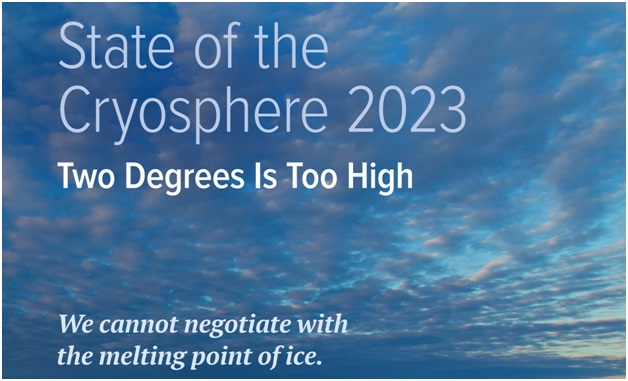State of the Cryosphere Report 2023 (DownToEarth)

- 18 Nov 2023
Why in the News?
As per the 2023 State of the Cryosphere report, the anticipated disappearance of almost all tropical glaciers, a significant majority of mid-latitude glaciers, and polar regions is expected, even if global efforts successfully limit the rise in temperatures to 2 degrees Celsius above preindustrial levels.
About the State of the Cryosphere Report 2023:
- The State of the Cryosphere Report annually assesses the condition of Earth's snow and ice regions, and has been reviewed and endorsed by over 60 leading cryosphere scientists.
- This report is published by The International Cryosphere Climate Initiative (ICCI.)
- The cryosphere is a term for the regions of our globe that are covered in ice and snow – either seasonally or year-round.
- The Report describes how a combination of melting polar ice sheets, vanishing glaciers, and thawing permafrost will have rapid, irreversible, and disastrous impacts worldwide.
Key findings in the report on the impact of 2°C of warming include:
- Ice sheets: nearly all of Greenland, much of West Antarctica, and even vulnerable portions of East Antarctica will be triggered to very long-term, inexorable sea-level rise.
- Glaciers: extensive, irreversible ice loss from the world’s glaciers in many major river basins, with some disappearing entirely.
- As glaciers melt, risks of catastrophic events such as landslides, sudden ice shears, and glacial lake outburst floods increase.
- Sea ice: extensive sea ice loss at both poles, with severe feedback to global weather and climate.
- By 2°C, the Arctic Ocean will be sea ice-free in summer every year, potentially for several months.
- Permafrost: extensive permafrost thaw and resulting greenhouse gas emissions will cause temperatures to continue to rise, even once human emissions reach zero.
- At 2°C, annual total permafrost emissions (both CO2 and methane) would total the size of the entire European Union’s emissions from 2019.
- Polar ocean acidification: year-round, permanent corrosive ocean acidification conditions in many regions of Earth’s polar and near-polar seas.
- Shell-building animals and commercial fisheries that rely on them in the food chain may not survive.
About International Cryosphere Climate Initiative (ICCI):
- It was formed in 2009 following COP-15 in Copenhagen
- ICCI is a network of senior policy experts and researchers working with governments and organizations to create, shape, and implement initiatives designed to preserve as much of the Earth’s cryosphere as possible.
- ICCI programs target the unique climate dynamics at work in the cryosphere, while at the same time lending increased urgency to global climate efforts aimed at CO2 and other greenhouse gases by communicating the unexpected rapidity and global implications of cryosphere warming.
